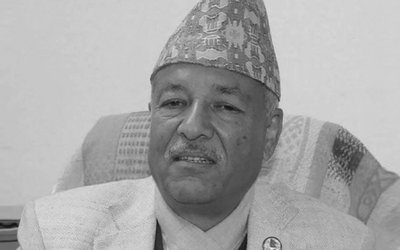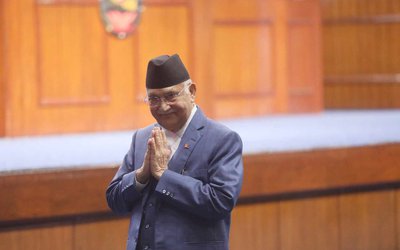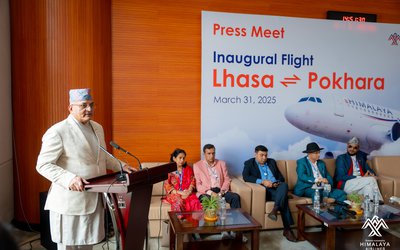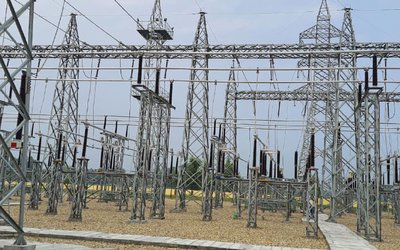
After a long struggle and series of controversies in the past twenty five years on the issue of leasing and purchasing aircraft, Nepal Airlines, Nepal’s national flag carrier, has finally added a new narrow body A320 aircraft in its fleet of aging two Boeing 757 jets. Facing stiff competition with other international airlines for its survival, the new aircraft will give Nepal Airlines a big boost to fly to new lucrative destinations in the region. However, given its history of frequent political interventions in the management, Nepal Airlines will still need to go a long way to change its image and regain the confidence in the international market
When Nepal Airline’s newly built A320 aircraft touched down on the runway of Tribhuwan International Airport on February 8, 2015, there was a great rejoicing and sharing of the moment of happiness among the Nepalese people. There was a sense of euphoria among the RA’s staff and others gathered at the airport to celebrate the arrival of the new aircraft as a big victory day.
The euphoria was spontaneous as Nepal Airlines had seen many ups and downs in its the process to purchase the new aircraft. It was as if the days were gone when aircraft leasing and purchasing were a matter of politics. Earlier, the government collapsed and managerial staff went to prison in scandals on leasing aircraft. Going through the history of the scandals, the arrival of the new aircraft deserved a fanfare.
Similarly, the new aircraft arrived when there was a looming despair and frustration among the people for their failure to see the new constitution thanks political clashes. At least, it made people jubilant for a moment.
“This is a historic day not only for Nepal Airlines but for the history of aviation in the country. We are able to add a new jet aircraft in our fleet of national flag carriers,” said Madan Kharel, General Manager of Nepal Airlines. “This makes all of us proud. After the success of this narrow body, we will go for wide body aircraft. The day is not far away."
The catalogue price of an aircraft is 75 million dollars (7.20 billion rupees). "We will bring another aircraft after the down payment. Nepal Airlines has to pay about 40-50 million rupees as a customs duty. It cannot fly without the clearance."
With the interest rate of 10 percent, Nepal Airlines secured the loan from Employees Provident Fund. It will now have to generate a huge amount of money to pay the loan as well as its interest. For this, there is the need to trim down the management with autonomy for General Manager to take a quick decision.
Challenges Galore
With the new aircraft, Nepal Airlines has now an added advantage to compete in the current market with much bigger and reputed airlines of Asia and region. Given Nepal Airlines history of political interference and politicized trade unions, Nepal Airlines bigger challenges will be to restore its own credibility.
“We have many challenges ahead. The main challenges are to win the confidence of passengers. We will provide high class service and regain their confidence. After induction of another Airbus, Nepal Airlines will be a profit making organization,” said Kharel.
The aircraft will make its maiden commercial flight in Kathmandu-New Delhi route on February 25. The Civil Aviation Authority has already given proven flight certificate to Nepal Airlines Aircraft for its flight from Doha and Kathmandu sector.
Euphoria and Satisfaction
After the arrival of first A320 aircraft, people from different walks of life were sharing their happiness and taking the situation as a pride for the country’s aviation history.
“The Airbus arrived and received the warmest welcome ever!!, writes Rensje Teerink, ambassador, European Union Delegation to Nepal, on her Facebook wall with photographs of the new A320. There are so many others who shared her feelings, writing comments.
“Great,” commented Dr. Sambhuram Simkhada in the Facebook wall of Rensje Teerink, who was among the guests, who went to the airport to see the A320 at Tribhuvan International Airport.
The Airbus can seat 158 passengers, including 8 in the business class.
Narendra Raule wrote Swagatam, Swagatam. Others also expressed similar views: “it feels so nice to see this in Nepal,” writes Anita Pariyar on Facebook.
Every day A 320 aircraft landed at the Tribhuwan International Airport for various private airlines and flag carriers of different countries, no body noticed the aircraft, until the country had its own. The challenges for NA now to maintain the level of euphoria and jubilation by offering the best management.
Reviving Old Destinations
Indian capital New Delhi is the most lucrative destination for the airlines. Still, Nepal Airlines had to suspend its flights over the last few years due to lack of aircraft. Following the suspension of Kathmandu-New Delhi flight by NA, there is virtually a cartel in the sector, with the airfare going up to R.30,000.00.
“Shortly after the arrival of the Airbus-made jets, we will start our flight to Guangzhou for the first time and resume previously suspended destinations like Bengaluru, Mumbai, New Delhi and Dubai,” said Nepal Airlines.
“The flight to New Delhi will be a great relief to the people,” said tourism entrepreneur Dhruba Narayan Shrestha. Resumption of flight to New Delhi is likely to reduce the current fare.”
With the capacity of 158 seats (including 8 business class seats), the second airbus made aircraft will be delivered by April. Although Nepal Airlines is preparing the operation plan for the new aircraft, people want its operation sooner.
“Can't wait to start flying Nepal Airlines again,” writes Saurav Jyoti, young industrialist of Nepal on his Facebook wall.
Promotion of Tourism
With the government’s plan to bring a million tourists this year, the resumption of Nepal Airlines flight to India's main cities, including New Delhi, Mumbai and Bangalore will lure more Indian tourists. Likewise, there will be more Chinese tourists coming from Guangzhou.
Everywhere, the travel industry has benefited greatly if the national carrier there is strong, vibrant and tourism friendly. Take the instance of the year 2000, when Nepal Airlines carried 149749 international passengers to Nepal. This unfortunately reduced to 13523 in 2013. If the Nepal Airlines operates flights in the tourist-generating sector, it will definitely yield positive results for the tourism industry of Nepal. Perhaps, the strengthening of Nepal Airlines will also check the unhealthy price competition of the international Airlines in Nepal sector for Nepal is now an expensive sector for travelers,” said Aditya Baral, senior director, tourism marketing and promotion department of Nepal Tourism Board.
Others too hold similar views. "Of course, the national flag carrier can play an important role in tourism promotion. After the induction of new A320, Nepal Airlines will occupy its early position to bring more international tourists in Nepal,” said Suresh Man Shrestha, secretary at Ministry of Culture, Tourism and Civil Aviation.
Technical Difficulties
Although Nepal Airlines is a small airline with limited number of aircraft, it has five different types of aircraft in its fleet. The challenge before Nepal Airlines now is to operate these different types of aircraft.
Nepal Airlines currently has Chinese Y 12 type, MI 60, Twin Otter, Airbus, and Boeing. According to the present guidelines of the Civil Aviation Authority of Nepal, a single fleet system needs three sets of pilots, that include three captains and three copilots for each aircraft.
Facing the scarcity of pilots, Nepal Airlines will need to spend a huge amount of money for running the five different fleets. The ageing Boeing 757 and Chinese Aircraft are likely to increase the operations cost.
NAC recently brought China-made MA 60 and Y12 model aircraft. MA 60 has been flying to urban destinations while Y 12 has been making trips to Pokhara and hinterlands of the country.
“Although the Boeing 737-800 would perhaps be a more suitable aircraft than the A320 and maintained fleet compatibility with NAC’s existing Boeings, the management seems to have decided to ditch Boeing for Airbus. Now that the decision has been taken, the question will arise what to do with the superannuated 757s, it is not feasible for a small airline like NAC to keep two jet types in its stable,” writes Hardik Gurung, a graduate student at University of Houston at Clear Lake in the US in Nepali Times.
History of Nepal Airlines
Established in July 1958 as Royal Nepal Airlines Corporation (RNAC) with a single Douglas DC-3, which used to serve the domestic routes and a handful of destinations in India, Nepal Airlines acquired its first jet aircraft, Boeing 727s, in 1972 and it added another Boeing 727 in 1985.
Inspired by the success of two Boeings, Nepal Airlines purchased two Boeing 757 in 1988, greatly enhancing its capacity in international flights, introducing flights to London and Germany.
After the political change of 1990, Nepal Airlines suffered badly due to frequent political interventions. However, it survived in the market because of the highest performance of Boeing 757.
The aircraft is powered by engines of US-based International Aero Engines.
Earlier, Sheel Shukla, senior sales director at Airbus, had said: “The engine chosen by NAC is one of the most fuel efficient engines (currently available in the market).”
Another prominent feature of the aircraft ordered by NAC is Sharklet fuel saving wing tip devices. These devices can save 3.5 per cent to four per cent of fuel, according to Airbus.
The aircrafts are also equipped with the latest Required Navigation Performance technologies, which allow the aircraft to fly precisely along predefined routes using state-of-the-art onboard navigation systems. This is particularly beneficial for operations at high altitude airports which are constrained by mountains such as the carrier’s main base in Kathmandu, as per Airbus.
With the new aircraft at its fleet, Nepal Airlines is now in a position to regain its image. However, much depends upon how political leadership takes the course.

Keshab Poudel
Poudel is the editor of New Spotlight Magazine.
- FM Dr. Deuba’s India Visit: Mission Aborted
- Mar 26, 2025
- AMBASSADOR MAEDA TORU: Warm Regards
- Mar 24, 2025
- PRO-MONARCHY MOVEMENT: Rising Dissatisfaction
- Mar 23, 2025
- Dr. PRABIN MANANDHAR: Person With Humility
- Mar 16, 2025
- US SUSPESION OF GRANT: Impact On Nepal
- Mar 10, 2025















